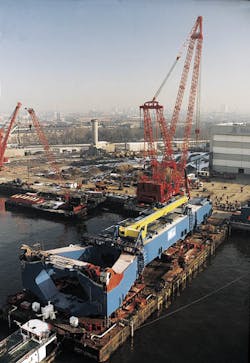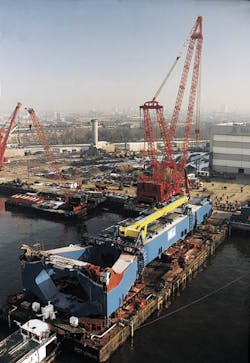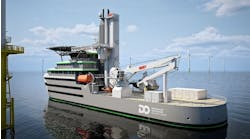World's deepest pipeline installation
Load-out of the lower part of the J-Lay tower (95 meters long, 14 meters high) in Rotterdam this February.Saipem's multi-purpose crane vessel/ pipelayer S7000 has departed Rotterdam in preparation for the first ultra-deepwater J-lay task. The vessel will install rigid risers and flowlines for Exxon's Diana project in the Gulf of Mexico. An even more challenging test of the system awaits in the Black Sea, where the Bluestream project partners have booked the vessel to lay the world's deepest submarine pipeline.
Much of the near-400 km, 24-in. diameter gas line across the Black Sea will be laid in water depths beyond 2,000 meters. Preparing the vessel for this role involved a five-month fit-out at the Verolme Botlek Ship & Offshore yard in Rotterdam.
Numerous changes were implemented:
- Conversion of a carpentry workshop into two boiler rooms
- Creation of new diesel generating rooms, including four 16V32 W?rtsil? NSD diesel engines
- Conversion of two ballast tanks into thruster rooms, with the number of thruster units increased from 10 to 12
- Construction of new transformer HVAC rooms and also of a separate high voltage room in the foreships area
- Installation of additional piping systems and fuel oil tanks.
While Saipem developed the high speed J-lay concept, Huisman-Itrec, in cooperation with Gusto Engineering, performed the main construction design. Huisman-Itrec's scope extended to design, manufacturing and testing of the tower angle adjustment system, the pipe handling equipment, and the line-up system. Saipem provided the tensioners and main clamps for the bottom of the tower, as well as coating, NDT, and welding equipment.
J-Lay overview
The J-lay system is designed to handle quadruple joints of rigid pipes with diameters varying from 4 in. to 32 in. These quadruples can be supplied either assembled or welded on board the S7000 using horizontal welding stations. The system can handle pipes up to 48 meters long and 32 in. in diameter, weighing around 50 tons.Welded quadruples are first lifted onto a longitudinal conveyor system then transported to the pipe loader, which up-ends the quadruple joint. An elevator picks the quadruple up and lifts it 50 meters upwards into the J-lay tower. The transfer system is hydraulically driven.
Optimum positioning of the pipe for welding (to an accuracy of within 0.2 mm) is managed by the Huisman-Itrec line-up tool. The welding station is located 58 meters above the main deck. Beneath it, three tensioners supported by an A-frame are positioned to hold the pipes, with a maximum capacity of 525 tons. Moveable clamps then replace the tensioners in a "hand-over-hand" process.
Located below the tensioners are the NDT station, which controls the weld using X-rays, and the weld coating station. Beneath the latter is a 550-ton capacity hang-off clamp. Also on the deck is a 550 ton abandonment and recovery (A&R) winch. Its 4 3/4-in. sheave-guided wire is used to lift the pipes onto the A&R head, then lower them into the sea.
Maximum pipe tension is 2,000 tons, with throughput onboard the vessel of up to 40 meters/min. Targeted laying speed is up to 5 km/day, which is similar to the rate currently achieved by Allseas' Solitaire. Full-scale trials will be conducted shortly in a Norwegian fjord, once the vessel returns from a current heavy lift exercise.
The J-lay equipment is modular, and can be assembled or disassembled within one week using S7000's own cranes. The A-frame is connected to the deck by a series of pins which can be retracted easily using hydraulic jacks. The 190-meter long, 50-meter wide Saipem 44 barge has been assigned to carry the equipment with 1,500 ton seafasteners deployed for safe storage. This vessel will accompany S7000 whenever it transits to a new deepwater J-lay site.
Angle variation
Water depths at Diana are over 1,500 meters. The S7000, which can operate in J-Lay mode in waves up to 5 meters, is due to lay the 6-in., 10-in., and 20-in. pipes early this fall. In fact, this will not be a major trial of the new equipment, as it is needed on Diana mainly for stretches at the ends of these lines where the stresses are critical.For Diana, the tower will be maintained at an angle of 20° off vertical - 90-110° - using an adjuster system controlled by hydraulic jacks. Should bad weather strike, it can be shifted to a 90° survival angle. This task is managed by operators of the control cabin 30 meters or so away, who also check pressure of cylinders and hydraulic valves as well as locking positions and other tasks. They can also vary the welding format from stepped to automatic to manual.
The Black Sea installation - dates have not been fixed yet - is a far longer J-Lay exercise which will require an adjustment of the tower angle to 115°,otherwise, the pipe will buckle. To cater for this deeper water operation, the tensioning system will also have to be reinforced, partly through extending the trusses. Once the upgrades are in place, however, they will not have to be changed back for future assignments, according to Huisman-Itrec.
Copyright 1999 Oil & Gas Journal. All Rights Reserved.




